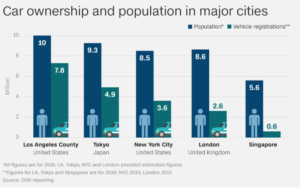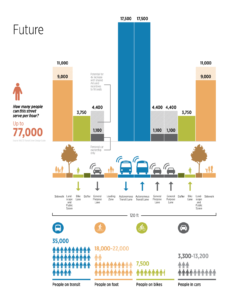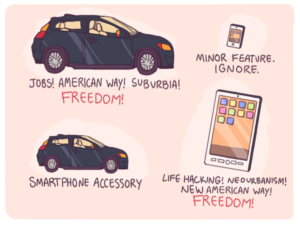This week California Governor Brown will host the historic global climate action summit with other global luminaries this week in San Francisco. The goal is to show the overwhelming groundswell of bottom up climate action from cities, companies and communities. The idea is that’ll stiffen the resolve of global grandees and show that while Washington DC has left Paris, most of America is still moving ahead and California is setting a model for the world.
One small problem: even in California we’re not doing close to enough. Much ink has been spilled on California’s new goals to achieve 100% renewable energy by 2045 and much more will be spilled analyzing the implications of the Governor’s Executive Order today on 100% decarbonization across the entire economy. There are many open questions about how to achieve that.
What’s certain is that will require a boldness and pioneering spirit as even with all of California’s progress we are still as addicted as ever to oil. Just look around at the cars around you (not to mention the petroleum embedded in the plastics we use and food we eat).
Moreover given increased global living standards, it’s not enough for California to cut to zero emissions (which are less than two percent of the globe anyway). The real challenge is figuring out how to enable the electrification of India without American-level carbon consumption. California needs to pioneer a post-carbon economy that the rest of the world wants to copy.
We’re failing in that regard. Many people smarter than I am have struggled with the incredibly complex economic linkages in international energy consumption. Yet more than wonky policy proposals what’s missing is a civic vision of what comes next. This is particularly obvious in LA with our sprawling single family suburbs and infamous traffic.
In LA, my hometown, we have ample symbolic gestures though far too little substantive action. That will sound harsh to the many talented folks who work on sustainability (like my colleagues around me at the LA Cleantech Incubator) but the reality is that the shiny plans the sustainability crowd likes to tout are no substitute for results on the ground. Traffic only gets worse and worse.
Even the plans fall short. LA’s two multi-billion dollar sales tax initiatives only aimed to “ease” traffic and the current insatiable demand for gas guzzling single occupancy vehicles threatens to undermine any meaningful decarbonization of the grid. It is a profound failure of civic vision to spend so much money to develop a public transit system that is still worse than what LA had with its red cars almost a century ago. We need a better alternative.
LA currently leads the world in the wrong direction. Rather than small measures to ease traffic, why are we not aiming to end traffic as we know it?

Source: https://www.cnn.com/2018/02/27/americas/los-angeles-traffic/index.html
Here existing technologies offer a frontier. There is an immense opportunity with autonomous vehicles to not only end traffic as we know it but also rapidly decarbonize the entire transportation sector. The big problem however is that autonomous vehicles emphatically do not yet work in all situations. There are still too many challenging circumstances where the technology does not work by itself as tragically shown in the uber accident earlier this year.
Technologists like to still claim that soon enough cars will be good enough to drive themselves. As a former Coro fellow, I would challenge the implicit presumption that we’ll ever have the exact map of the entire world that self driving cars require. Purely technical types too quickly forget that maps are a human invention and not an actual aspect of the world in which we live. Of course that does not mean that maps cannot be extremely useful tools!
What my fellow public servants miss is that the technology does not need to be perfect in order to be better than existing alternatives. Upwards of seventy percent of the operating cost of a bus can come from the driver. Autonomous vehicles are already working to shuttle people around tech and other college campus like settings. Autonomous buses already make the rounds in Shenzen, China. Pilots are underway in Austin, Texas to deploy autonomous shuttles in controlled urban corridors.
Autonomous buses offer incredible cost savings opportunities and thus the ability to dramatically expand LA’s public transit network. Imagine fast, rapid public transit on every freeway and major street across the Southland. The coverage would be dramatically better than the red cars and would thus offer a much more compelling alternative to sitting stuck in your car. Our current tiny public transit system really doesn’t work all that well. It doesn’t make a lot of sense to have a centralized system given how decentralized the web of suburbans that we call LA really is. It’s hugely suboptimal to have to go through union station when you’re trying to get between Santa Monica and Orange County.
An LA covered with AV buses would also mean dramatically less traffic and less GHG’s (zero in fact if they’re electric autonomous vehicles powered by all that new California renewable energy). It’s simple geometry. Buses fit more people per section of street and thus can transport many, many more people than existing road lanes. The image below from Emily Castor Warren (formerly head of policy at Lyft) shows the potential increased throughput that maximizes existing streets and freeways across LA, saving zillions on Elons exciting but expensive Boring company tunnels.

(The entire Lyft vision for Southern California is worth a read… https://medium.com/@emilycwarren/a-new-vision-for-los-angeles-streets-74613e2f0dba )
Last mile problems could be addressed through a combination of ride sharing (hop on a Lyft), electric scooters and bikes. We could also actually get serious about new urbanism and create massively more mixed use spaces that make those final connections a short walk away. Radical idea right? LA could stop pretending its two hundred small towns and have the density that really every other city on the planet already has.
Automating dedicated bus lanes also offers a first step to a fully autonomous future where one can be whisked precisely from their current location to destination at the push of a button. In addition to ending traffic as we know it, that future also means that older Californians can more easily be mobile. And low cost, rapid, clean autonomous transit means we can build a world where all Californians can easily move between where they live, work and play — not just the privileged few that can do so today.
That Los Angeles isn’t just greener — it’s better for everyone.
Building that future will not be easy. It’ll take a lot of patience and public education to explain the virtue of this newfangled autonomous approach. Let’s also not forget though how much the status quo sucks. In addition to spewing out smog (thank you for giving me asthma) and greenhouse gases (anyone looking forward to LA in a 2+ degree scenario?), time wasted in traffic has huge economic costs and also eats at your soul. Cars also kill a lot of people. For many millennials, cars are no longer the symbol of freedom. It’s smartphones.

Source: https://breakingsmart.com/en/season-1/a-new-soft-technology/
That enhanced freedom highlights how a post-carbon economy can not only be good for the environment but objectively better than our gridlocked status quo. That’s exactly what California needs to aim towards if we’re going to get the rest of the world to follow us. That will require the courage to get outside of our comfort zones as people love driving their cars — of course that’s par for the course in California which has led the world into new frontiers since 1849.
The history of the California water industry in particular offers lots of lessonsfor deploying new technology to tackle big public challenges. William Mulholland built the LA aqueduct using experimental caterpillar technology. The bond used to pay for the Colorado River Aqueduct was approximately ten percent of the value of every property across Southern California. We have done it before and our generational challenge with climate change is to do it again.
Like WWII, winning that war will require shaking ourselves out of the peacetime complacency. We cannot congratulate ourselves simply for setting goals and must also lay the foundation. California at its best stands ideally poised to break the cycle of global climate inaction and lead the world into a post-carbon future. 8 years ago, Governor Brown embarked on his quest to become California’s once and future Governor by reflecting on the challenges facing the state:
“It’s the state of imagination. This is the place of Hollywood movies. This is the place of rocket ships. It’s the place of wind machines. It’s the place of all sorts of ideas… We’ve been in California a long time and there’s a pioneering spirit, and what we face today is a very screwed up state of politics… It’s broken. It’s a breakdown. But if we can summon up the spontaneity and creativity of California, we can transform what is a breakdown into a breakthrough.”
Today California’s budget is balanced and Governor Brown made foundational progress that positions California for a breakthrough. Setting big goals and aiming to pioneer a post-carbon economy will scare some people. But just like traffic in LA sucks, let’s remember that the old economy isn’t working anyway. So like our California ancestors before us, let’s have the courage to burn our wagons and pioneer the new.
Patrick Atwater is the Executive Director of Applied Research in Government Operations (ARGO), a public data infrastructure nonprofit who’s big claim to fame is delivering California’s first ever measurements of Governor Brown’s historic new water efficiency legislation.

